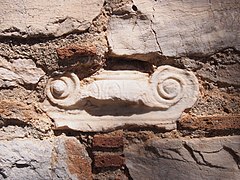
Back استخدام ثانوي (عمارة) Arabic Споліі Byelorussian Spolia Catalan Spolie German Spolio Esperanto Spolia Spanish Spolia Estonian Spolia French שימוש משני HE Spolij Croatian

Spolia (Latin, 'spoils'; sg.: spolium) are stones taken from an old structure and repurposed for new construction or decorative purposes. It is the result of an ancient and widespread practice (spoliation) whereby stone that has been quarried, cut and used in a built structure is carried away to be used elsewhere. The practice is of particular interest to historians, archaeologists and architectural historians since the gravestones, monuments and architectural fragments of antiquity are frequently found embedded in structures built centuries or millennia later. The archaeologist Philip A. Barker gives the example of a late Roman period (probably 1st-century) tombstone from Wroxeter that could be seen to have been cut down and undergone weathering while it was in use as part of an exterior wall and, possibly as late as the 5th century, reinscribed for reuse as a tombstone.[1]
- ^ Barker, A. Philip (1977). Techniques of Archaeological Excavation. Routledge. p. 11.
© MMXXIII Rich X Search. We shall prevail. All rights reserved. Rich X Search